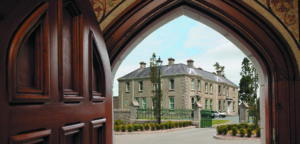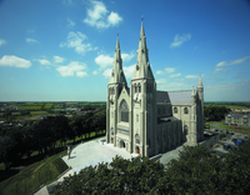DEDICATION OF CHURCH OF ST. PATRICK, CASTLEDAWSON
(PARISH OF MAGHERAFELT)
SUNDAY 6 MAY 2001
HOMILY BY CARDINAL SEÁN BRADY
This is the day, which the Lord has made for the dedication of your beautiful new church, to the praise and glory of His name, and to the honour of our national apostle, Patrick. This is a special day for you, the faithful people of Castledawson. This is a special day for the people and priests of parish of Magherafelt. It is also a special day in the life of the Archdiocese of Armagh as we see, raised up here, on the bank of the Moyola, at the northern extremity of the diocese, and dedicated to the glory of God, one of the first churches in Ireland, to be dedicated in the new millennium.
You, the Catholic community here in Castledawson, decided that you needed a church. In other words you decided that you needed a building in which you could gather to hear the Word of God, to pray together, to celebrate the sacraments and above all to celebrate holy Mass. You then set about providing that church. And so here we are, gathered to dedicate your splendid new church with solemnity and ceremony, in accordance with the ancient custom of the Church. My heartiest congratulations go to all of you but especially to your Parish Priest, Canon O’Byrne. For him this is the fulfilment of a long cherished ambition. Canon Chris, we rejoice and are proud with you on this splendid occasion. I know you got tremendous co-operation and generous support from the people of the parish and great help from your curates – Father Russell and Father Moore – and I am sure also from the Sisters of the Holy Family of Bordeaux. Yes, this is a wonderful day for all of you – let us rejoice and be glad.
Our first prayer today is one of praise and thanks to God. Today we thank God for raising up in His Church, in every age, people with greatness of soul and nobility of character. For any parish which sets about building a new Church has to have many noble souls, who are possessed of high ideals and unselfish thoughts, people who are prepared to undertake great things for God and for the sake of the people of the parish. We salute you today, the people of Castledawson, for your valiant and generous spirit because you were ready to undertake great work and great expense. We also give thanks to God for the many talented and skilled people who were able to take your ideas and your wishes and transform them into such a beautiful building. I am of course referring to the architects and artists, the contractors, the engineers, the technicians, the tradesmen and the attendants. They are listed at the back of the book.
How appropriate that this splendid church should be dedicated to St. Patrick. In his Confession, Patrick tells us that during his captivity he was put herding sheep near the Wood of Uliti. One scholar located that wood east of Lough Neagh. Another thought it was Magherafelt. Of course tradition also tells us that he herded sheep on Slemish in County Antrim which is not 100 miles away from here.
A biography of Patrick, written in early Irish and dated from the middle of the 8th century, tells us that he crossed the Bann at Toomebridge. It says that he came into this territory of South Derry and East Tyrone, which was then the territory of McFlynns, or O’Flynns. I am glad to see from the phonebooks that there are a number of that family still around in this area.
We are told that Patrick spent 40 nights around here and wanted to build a city here because he considered it a lovely place with Slieve Gallen on one side and Lough Neagh on the other.
Yesterday a young lady in Cookstown took Trea as her Confirmation name. You know of course that the ancient name of the parish of Moneymore is Ardtrea. The Church in Moneymore is dedicated to St. John and St. Trea. Tradition has it that Trea was the daughter of McCartan and that Patrick blessed her in the womb of her mother and foretold that she would grow into a saintly person. Trea appears to be one of those early influential saints of our diocese like Brigid of Faughart in County Louth and Moninna of Killeavy in South Armagh, who played an important part in the development of the Christian faith in Ireland.
When a church is dedicated, such appointments as its baptismal font, cross, statutes, bells, stations of the cross, are all considered to be as blessed. They therefore need no further blessing. Castledawson is linked to the early days of christianity through the famous Bell of St. Patrick. The bell of St. Patrick is a simple cowbell. It may well date back to the time of the saint himself. It is one of the glories of early Irish art. For almost a 1000 years the task of caring for that bell and preserving it was shared between the Mulhollands of Castledawson and the Ó Mealláins of Lissan. Just over 200 years ago a certain Henry Mulholland, of Shane’s Castle, was on his deathbed. He sent for his friend Adam McClean and told him to dig under a tree in the garden where he would find the only treasure which he, Henry, had in this world. McClean found buried in the garden an old trunk containing a copy of the Bible and the bronze bell of St. Patrick, splendid in its beautiful shrine. The bell subsequently made its way to the National Museum in Kildare Street, Dublin where it can be seen today.
What the precise function of this glorious relic was is not at all clear. In the Middle Ages it was used as a bell in Church services and on ceremonial occasions. It was also used in the business of settling disputes and the making of agreements between families and peoples. The Mulhollands in this parish and the Ó Mealláin in Lissan, were Erenagh families, that is families with a whole range of church duties and privileges passed to them. They were the keepers of Church property, responsible for the provision of priests in the local communities. Today is Vocations Sunday. It is a day on which we recall the fact that everyone, not just the priests and the nuns, the brothers, have a vocation in life. We all have a vocation to holiness. It is also the day on which we recall the fact that God does in fact call people to serve him as priests and brothers and nuns. We have moved on a little bit from time when the responsibility of providing priests for a parish was considered to be the responsibility of one or two or three families.
Today we are carrying on a long and noble tradition. As I come here today I know that I come as part of that tradition. It comes down from Patrick to Malachy to St. Oliver Plunkett. In every age the followers of Christ are tempted to back with tradition and to give up their faith in Christ. The temptation is always clever. It is a temptation to cease to believe in Christ as the good shepherd – The Good Shepherd who laid down His life for his sheep. Writing for today – Vocations Sunday – Pope John Paul II says “The great temptation of our western culture today is to put God on the sidelines of daily life, to relegate Him to the margins, to keep Him in a very small box indeed”. So the Holy Father calls the whole Christian community to re-evangelise life. He says, “so many young people are hungry and thirsting for values today. They are often incapable of finding the way, which leads to those values. Christ and Christ alone is the way, the truth and the life”. They must be helped to meet the lord and to build up a deep friendship with Him.
My prayer is that in this, your beautiful new church that you will be able to come together to meet the Saviour, Jesus Christ, and to establish a deep relationship with Him. Jesus must enter into the world of each one of us, become part of our history. We must open our hearts to Him and learn to know Him each day more deeply so that we can follow Him more faithfully and more lovingly. In this beautiful new Church may each one of you come to know Jesus Christ, the Good Shepherd more fully.
The Bell of St. Patrick may be in different hands at different times. Yet the message of Patrick is always the same. It has to be the same message – the Message of Jesus Christ – the message of Eternal Life. It is that each one of us is called to enter into a relationship with God, a relationship of love. We do so by listening to the voice of Jesus, the Good Shepherd, who was sent by God to save us. We are to get to know Him. We follow Him when we keep His commandments. That is the only way to eternal life, the one and only route to everlasting happiness. Yes, you are God’s building; Jesus Christ is the foundation. The temple of God is sacred and you are that temple.
AMEN



You must be logged in to post a comment.